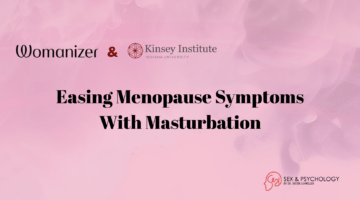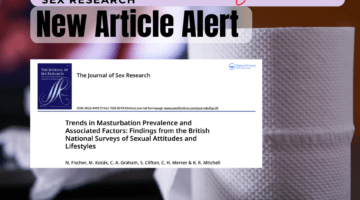Do Women’s Genital Arousal Patterns Change When They’re Ovulating?
May 14, 2014 by Justin Lehmiller
Several studies have found that when heterosexual women view different types of pornography, they tend to show a nonspecific genital arousal pattern with respect to the gender of the performers [1]. In other words, heterosexual women typically register high levels of genital arousal in response to both gay male porn and lesbian porn. In contrast, men tend to show more specificity in their genital responses, with heterosexual men only showing strong genital arousal when watching porn that features women, and gay men only showing strong genital arousal when watching porn that features men.
It is not clear why heterosexual women typically show this gender-nonspecific arousal pattern; however, one possibility that researchers did not consider until just now is that perhaps women’s genital response patterns are not constant and, instead, fluctuate across the menstrual cycle for evolutionary reasons. For instance, it could be that when the odds of conception are low, women have a nonspecific arousal pattern, perhaps to allow more flexibility in finding a partner who can help with child-rearing in the event that the father of her children is no longer alive or contributing resources. In contrast, when the odds of conception are high (i.e., during ovulation), perhaps women’s genital arousal patterns shift toward men in order to increase their odds of reproductive success.
This idea that there might be an ovulatory shift in women’s genital arousal patterns would seem logical in light of a growing body of research demonstrating that when women are at peak fertility, their mating preferences and behaviors change. Specifically, ovulating women tend to be more attracted to guys with masculine-looking faces and bodies, deeper voices, and dominant personalities, presumably because those traits signal better genetic fitness and, thus, a higher likelihood of being able to father babies who will survive. In light of these findings, a new study published in the Archives of Sexual Behavior sought to test whether women’s genital arousal patterns also show an ovulatory shift [2].
In this study, participants consisted of 22 heterosexual women who were naturally cycling (i.e., not taking any hormonal contraceptives). Each woman watched a series of 16 video clips while hooked up to a device that records vaginal arousal. The videos included a mix of female pornography (e.g., a woman masturbating, two women having sex), male pornography (e.g., a man masturbating, two men having sex), and neutral scenes (e.g., landscapes). The women watched these video clips during two different phases of the menstrual cycle: once while their odds of conception were high (i.e., during the follicular phase) and once while their odds of conception were low (i.e., during the luteal phase). Prior to watching the videos, saliva samples were collected and subjected to hormone tests in order to establish where women were in their cycles.
So what did the researchers find? It turned out that there was no ovulatory shift in women’s genital arousal patterns. That is, when women were at peak fertility, they did not show a stronger genital response to pornography featuring men than they did at a time of low fertility. In fact, women showed the same nonspecific pattern of genital arousal that was observed in previous studies during both phases of testing.
What does all of this mean? For one thing, it suggests that heterosexual women’s nonspecific genital arousal patterns are even more robust that previously thought. However, it also suggests that the sexual arousal system is separate from whatever system has control over mating preferences. Although this might not sound intuitive, there may be good reasons for these systems to be separate. For instance, while mate preferences may fluctuate across the menstrual cycle in order to help women obtain the best genes for producing offspring, it could be that having constant, nonspecific genital arousal serves a different, but still very adaptive purpose. As mentioned above, one possibility may be to grant flexibility when it comes to finding a partner for child-rearing (this is known as the alloparenting hypothesis, and you can read more about it here). However, another possibility proposed by the current study’s authors is that it may “reduce the risk of vaginal/vulvar injury from penetrative sex, regardless of sexual partner identity and cycle phase.”
In short, although heterosexual women’s mating preferences and behaviors may change according to their fertility status, it appears that their genital arousal patterns do not.
**September 6, 2015 Update: A more recent study from the same lab has documented ovulatory shifts in genital arousal patterns in response to images of penetrative vs. oral sex. For an abstract of the newer study, see here.
Want to learn more about Sex and Psychology? Click here for more from the blog or here to listen to the podcast. Follow Sex and Psychology on Facebook, Twitter (@JustinLehmiller), or Reddit to receive updates. You can also follow Dr. Lehmiller on YouTube and Instagram.
[1] Chivers, M. L., Rieger, G., Latty, E., & Bailey, J. M. (2004). A sex difference in the specificity of sexual arousal. Psychological Science, 15, 736–744.
[2] Bossio, J. A., Suschinsky, K. D., Puts, D. A., & Chivers, M. L. (2013). Does menstrual cycle phase influence the gender specificity of heterosexual women’s genital and subjective sexual arousal? Archives of Sexual Behavior.
Image Source: iStockphoto

Dr. Justin Lehmiller
Founder & Owner of Sex and PsychologyDr. Justin Lehmiller is a social psychologist and Research Fellow at The Kinsey Institute. He runs the Sex and Psychology blog and podcast and is author of the popular book Tell Me What You Want. Dr. Lehmiller is an award-winning educator, and a prolific researcher who has published more than 50 academic works.
Read full bio >


